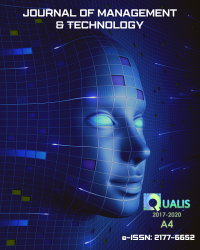The ecosystems as a new stage of retail development
DOI:
https://doi.org/10.20397/2177-6652/2023.v23i1.2574Palavras-chave:
Ecosystem, Retail, New business environment, Coopetition, Interaction, ModulesResumo
The article deals with three groups of research on the topic of ecosystems: ecosystems as biological systems, ecosystems as structures and ecosystems as ways to create a value proposition. The author substantiates that ecosystems are non-hierarchical structures of relationships in order to create such a common value that a single firm would not be able to create alone. Modern authors, considering business models of retail, focus on the impact of digitalization and put the creation of value for customers at the forefront. The article gives examples of innovation ecosystems of the largest retailers, which made it possible to confirm that they do not have hierarchical management as in classic business models, since the so-called “center” consists of hundreds of companies, a powerful IT architecture. It is revealed that since ecosystems mean organization within organization without hierarchical types of management, this requires the development of internal entrepreneurship and skills of systemic interaction. It is necessary to transform one's own consciousness and the consciousness of a whole generation that will interact within the framework of ecosystems, which requires universities to educate students new types of skillsReferências
Adner, R. (2017). Ecosystem as structure: An actionable construct for strategy. Journal of Management, 43(1), 39-58. http://dx.doi.org/10.1177/0149206316678451
Böttcher, T. P., Rickling, L., Gmelch, K., Weking, J., Krcmar, H. (2021). Towards the digital self-renewal of retail: The generic ecosystem of the retail industry. In Ahlemann, F., Schütte, R., & Stieglitz, S. (Eds.), Innovation through information systems. WI 2021. Lecture notes in information systems and organisation (vol. 46, pp. 140-146). Cham: Springer. http://dx.doi.org/10.1007/978-3-030-86790-4_11
Cao, L. (2014). Business model transformation in moving to a cross-channel retail strategy: A case study. International Journal of Electronic Commerce, 18(4), 69-96.
Casadesus-Masanell, R., & Ricart, J. E. (2010). From strategy to business model and onto tactics. Long Range Planning, 43(2), 195-215.
Data Insight. (2020). DI-EcosystemMarketplaceOzon-2020-Report. https://datainsight.ru/sites/default/files/DI-EcosystemMarketplaceOzon-2020-Report.pdf
Iansiti, M., & Levien, R. (2004). The keystone advantage: What the new dynamics of business ecosystems mean for strategy, innovation, and sustainability. Boston, MA: Harvard Business School Press.
Jacobides, M. G., Cennamo, C., & Gawer, A. (2018). Towards a theory of ecosystems. Strategic Management Journal, 39(8), 2255-2276. http://dx.doi.org/10.1002/smj.2904
Konstantinov, G. N. (2019). Entrepreneurial talent in the cognitive world. Interview Series. YouTube. https://www.youtube.com/watch?v=68azoK7-vPY
Kretschmer, T., Leiponen, A., Schilling, M., & Vasudeva, G. (2020). Platform ecosystems as meta-organizations: Implications for platform strategies. Strategic Management Journal, 43(3), 405-424. http://dx.doi.org/10.1002/smj.3250
Markin, R. J., & Calvin, P. D. (1981). The transformation of retailing institutions: Beyond the wheel of retailing and life cycle theories. Journal of Macromarketing, 1(1), 58-66.
McKinsey & Company. (2021, June 7). Building ecosystems around physical and online grocery offerings: An interview with Per Strömberg. https://www.mckinsey.com/industries/retail/our-insights/building-ecosystems-around-physical-and-online-grocery-offerings-an-interview-with-per-stromberg
Moore, J. F. (1993). Predators and prey: A new ecology of competition. Harvard Business Review, 71(3), 75-86.
Mostaghel, R., Oghazi, P., Parida, V., & Sohrabpour, V. (2022). Digitalization driven retail business model innovation: Evaluation of past and avenues for future research trends. Journal of Business Research, 146(2), 134-145. http://dx.doi.org/10.1016/j.jbusres.2022.03.072
Nordmark, J. (2020, June 17). Amazon’s ecosystem map. Medium. https://medium.com/@jonnordmark/amazons-ecosystem-map-d25abcac9613
Okunola, M. A. (2021). The future of Amazon: Coopetition, big data and EU antitrust. A mixed-method single case study-realist review arranged in a series. A postgraduate major project submitted in partial fulfilment of the degree of Master of Business Administration. International Anglia Ruskin University, London. http://dx.doi.org/10.13140/RG.2.2.20756.01924
Osterwalder, A., & Pigneur, Y. (2010). Business model generation: A handbook for visionaries, game changers, and challengers. Hoboken, NJ: John Wiley & Sons, Inc.
Parker, G. G., Van Alstyne, M. W., & Choudary, S. P. (2016). Platform revolution. New York, NY: Norton and Co.
Rakuten. (n.d.). Rakuten Group Ecosystem. https://global.rakuten.com/corp/about/
Retail Technology Innovation Hub. (2022, February 22). X5 Group and Sber discuss ecosystem partnership expansion. https://retailtechinnovationhub.com/home/2022/2/22/x5-group-and-sber-discuss-ecosystem-partnership-expansion
Schön, O. (2012). Business model modularity – A way to gain strategic flexibility? Controlling & Management, 56(2), 73-78.
School of Constructed Environments. (n.d.). Building product ecosystems. https://sce.parsons.edu/blog/building-product-ecosystems/
Sorescu, A., Framback, R. T., Singh, J., Rangaswamy, R., & Bridges, C. (2011). Innovations in retail business models. Journal of Retailing, 87(1), 83-96.
SupplierGATEWAY. (n.d.). Global supplier management platform. https://www.suppliergateway.com/sustainability-assessments/
Teece, D. J. (2014). Business ecosystems. In Augier, M., & Teece, D. J. (Eds.), Entry in Palgrave encyclopedia of management (pp. 1-4). London: Palgrave Macmillan. https://doi.org/10.1057/978-1-349-94848-2_724-1
Downloads
Publicado
Como Citar
Edição
Seção
Licença
Copyright (c) 2023 Revista Gestão & Tecnologia

Este trabalho está licenciado sob uma licença Creative Commons Attribution-NonCommercial 4.0 International License.
Os direitos, inclusive os de tradução, são reservados. É permitido citar parte de artigos sem autorização prévia desde que seja identificada a fonte. A reprodução total de artigos é proibida. Em caso de dúvidas, consulte o Editor.


